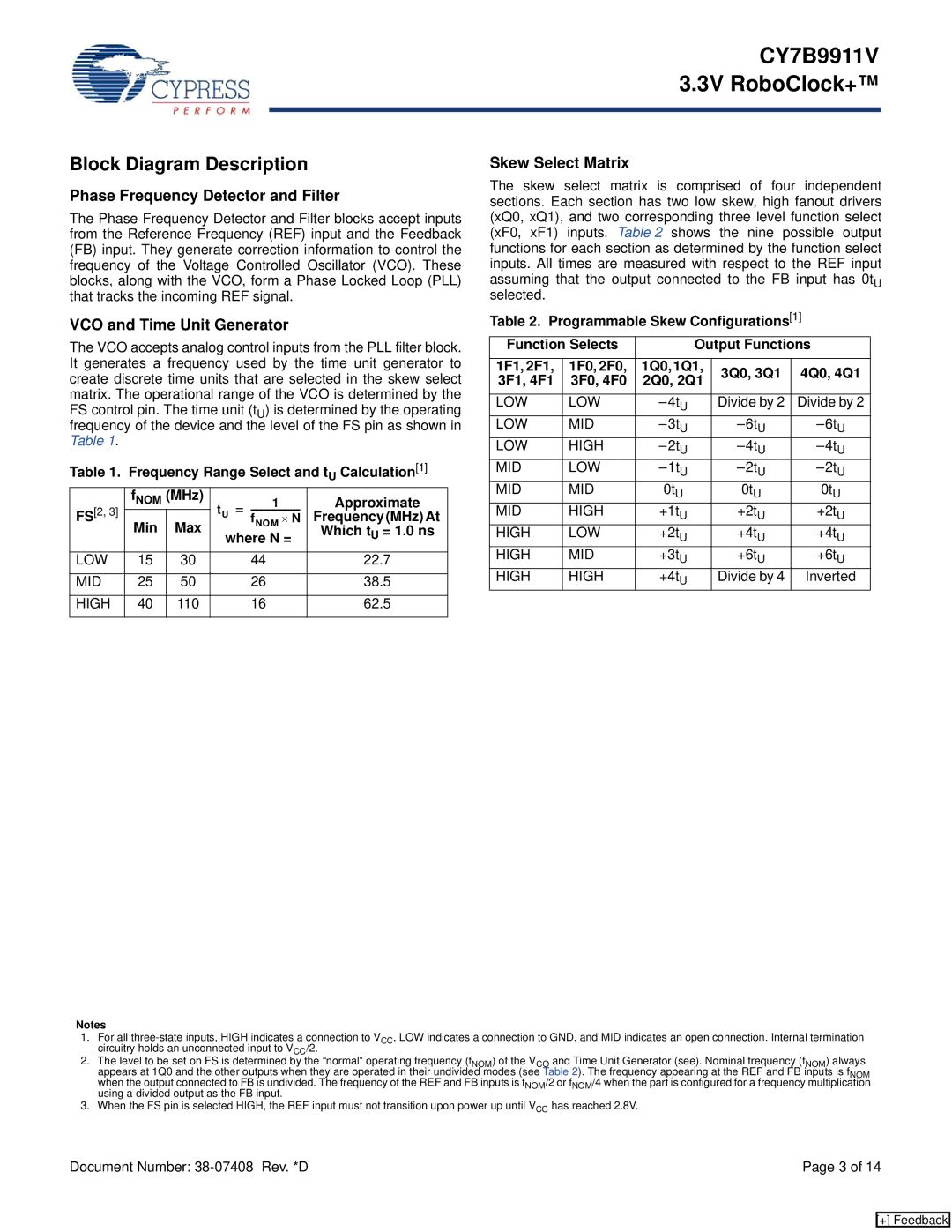
CY7B9911V 3.3V RoboClock+™
Block Diagram Description
Phase Frequency Detector and Filter
The Phase Frequency Detector and Filter blocks accept inputs from the Reference Frequency (REF) input and the Feedback (FB) input. They generate correction information to control the frequency of the Voltage Controlled Oscillator (VCO). These blocks, along with the VCO, form a Phase Locked Loop (PLL) that tracks the incoming REF signal.
VCO and Time Unit Generator
The VCO accepts analog control inputs from the PLL filter block. It generates a frequency used by the time unit generator to create discrete time units that are selected in the skew select matrix. The operational range of the VCO is determined by the FS control pin. The time unit (tU) is determined by the operating frequency of the device and the level of the FS pin as shown in Table 1.
Table 1. Frequency Range Select and tU Calculation[1]
|
| fNOM (MHz) | tU = | 1 |
| Approximate | |
FS | [2, 3] |
|
| Frequency(MHz)At | |||
| Min | Max |
| fNOM | ⋅ N | ||
|
| where N = | Which tU = 1.0 ns | ||||
|
|
|
| ||||
LOW | 15 | 30 |
| 44 |
| 22.7 | |
|
|
|
|
|
|
| |
MID | 25 | 50 |
| 26 |
| 38.5 | |
|
|
|
|
|
|
| |
HIGH | 40 | 110 |
| 16 |
| 62.5 | |
|
|
|
|
|
|
|
|
Skew Select Matrix
The skew select matrix is comprised of four independent sections. Each section has two low skew, high fanout drivers (xQ0, xQ1), and two corresponding three level function select (xF0, xF1) inputs. Table 2 shows the nine possible output functions for each section as determined by the function select inputs. All times are measured with respect to the REF input assuming that the output connected to the FB input has 0tU selected.
Table 2. Programmable Skew Configurations[1]
Function Selects | Output Functions | ||||
1F1, 2F1, | 1F0, 2F0, | 1Q0,1Q1, | 3Q0, 3Q1 | 4Q0, 4Q1 | |
3F1, 4F1 | 3F0, 4F0 | 2Q0, 2Q1 | |||
|
| ||||
LOW | LOW | Divide by 2 | Divide by 2 | ||
LOW | MID | ||||
LOW | HIGH | ||||
MID | LOW | ||||
MID | MID | 0tU | 0tU | 0tU | |
MID | HIGH | +1tU | +2tU | +2tU | |
HIGH | LOW | +2tU | +4tU | +4tU | |
HIGH | MID | +3tU | +6tU | +6tU | |
HIGH | HIGH | +4tU | Divide by 4 | Inverted | |
Notes
1.For all
2.The level to be set on FS is determined by the “normal” operating frequency (fNOM) of the VCO and Time Unit Generator (see). Nominal frequency (fNOM) always appears at 1Q0 and the other outputs when they are operated in their undivided modes (see Table 2). The frequency appearing at the REF and FB inputs is fNOM when the output connected to FB is undivided. The frequency of the REF and FB inputs is fNOM/2 or fNOM/4 when the part is configured for a frequency multiplication using a divided output as the FB input.
3.When the FS pin is selected HIGH, the REF input must not transition upon power up until VCC has reached 2.8V.
Document Number: | Page 3 of 14 |
[+] Feedback
